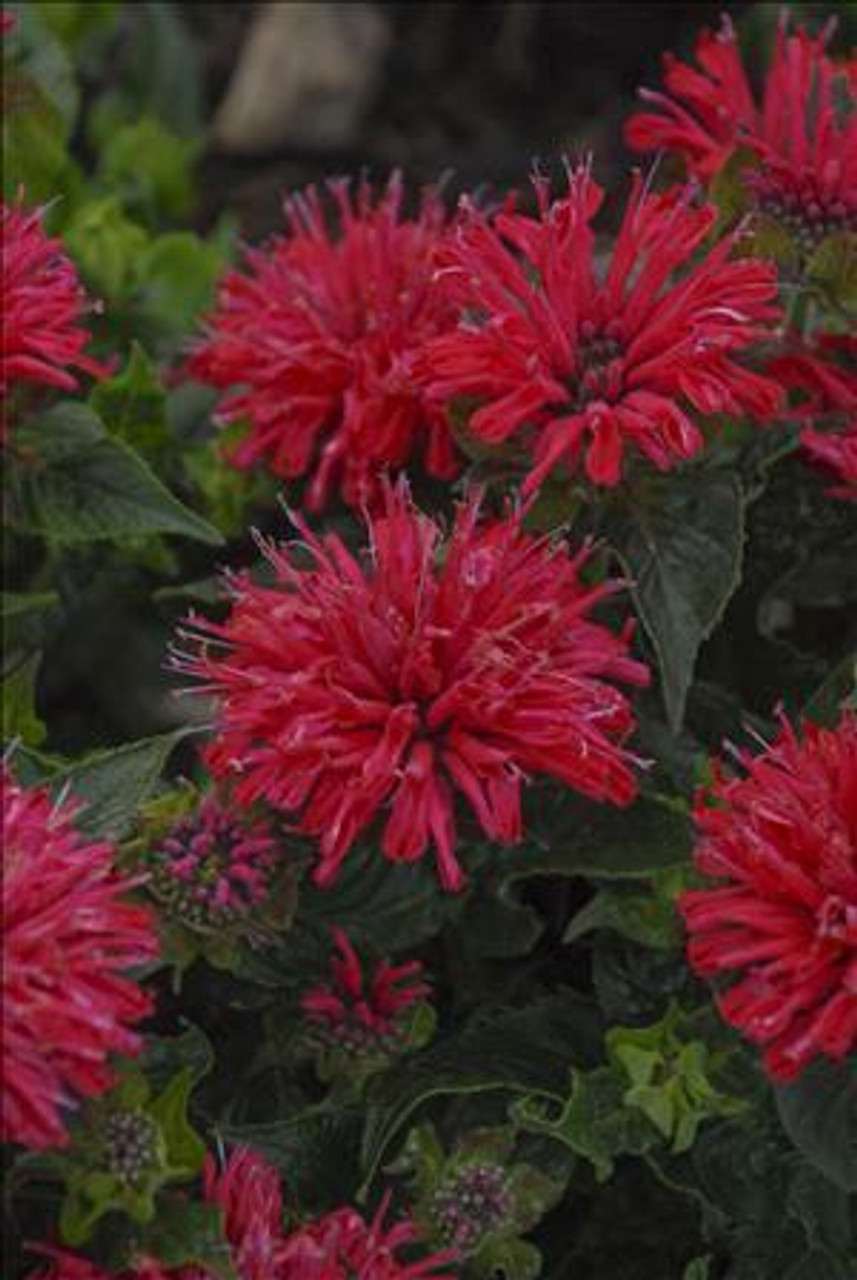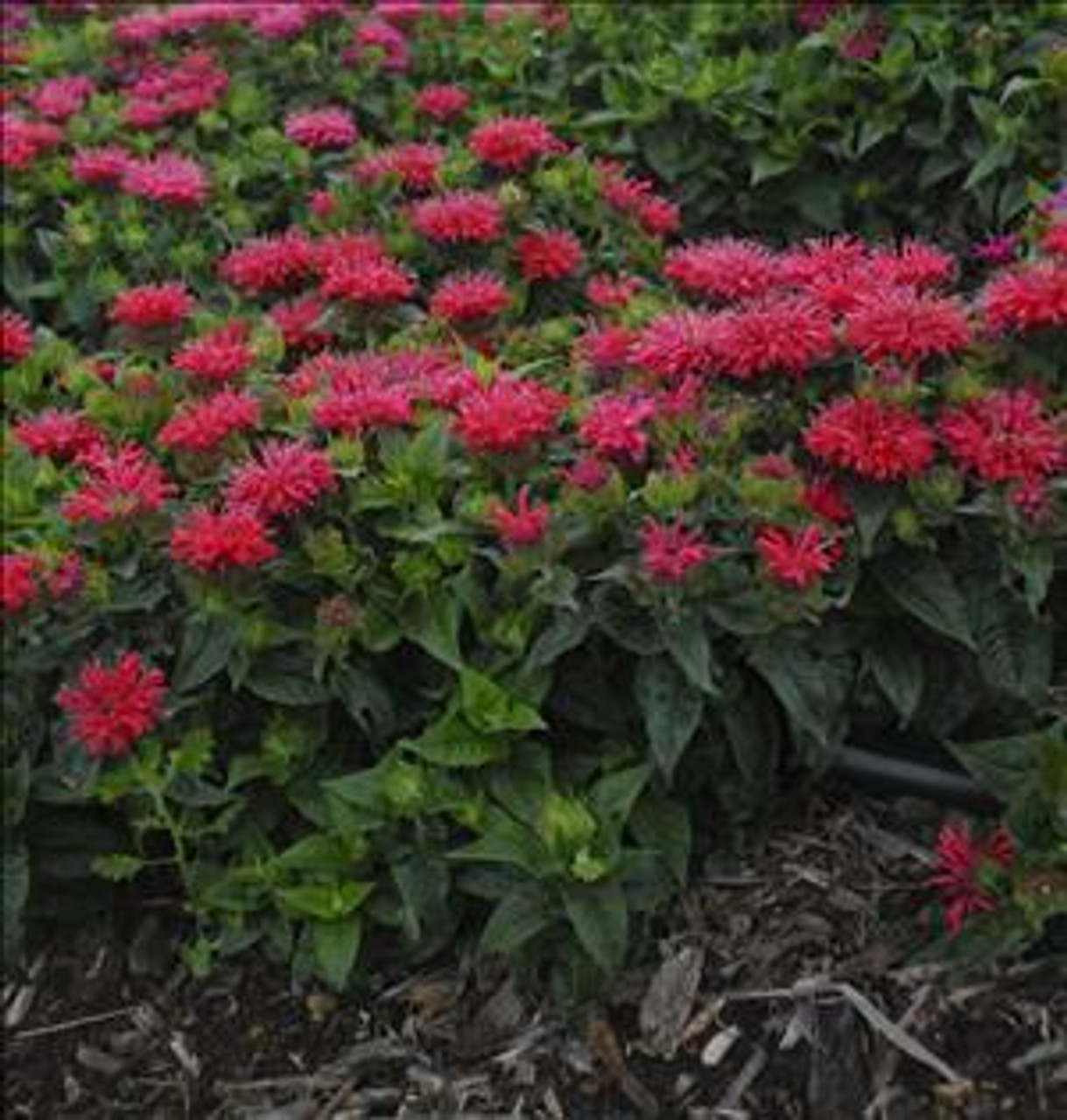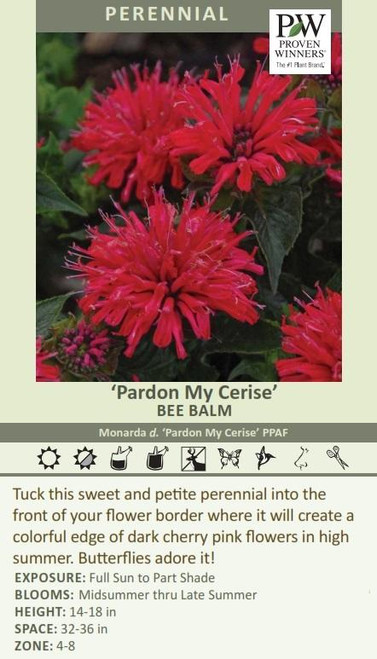Product Description
Monarda didyma 'Pardon My Cerise' PP29234 CPBR5725 (20)ct Flat
Pardon My Series
Common Name: Bee Balm
No room for the tall, bushy, traditional Bee Balm in your garden? Here is a petite selection that’s easy to tuck into the front of your sunny border and combination containers. Reaching just a little over a foot tall at maturity, this compact selection forms a bushy, well-branched clump of green, semi-glossy foliage.
From mid through late summer, dark cherry pink flowers sit just at the top of the foliage. Though the plant may be dwarf, the flowers are the same size as taller selections, measuring a full 2½-3" across. They add a bright splash of color to the border in high summer.
This selection also offers good resistance to powdery mildew, a problem with many older Bee Balms. Just provide good air circulation, sunshine, and plenty of water and these plants will thrive!
Monarda is native to eastern North America, so it is easy to grow and it multiplies quickly. The flowers' sweet nectar attracts scores of hummingbirds, butterflies, and bees to the garden. The aromatic foliage smells like mint when crushed and is often used to flavor teas.
Monarda can be found naturally along riverbanks and enjoys this rich, organic, moist soil. However, it will grow in average soil as well. Full sun is best, but light shade is tolerated. Plants tend to spread more quickly in the shade. Most monardas multiply rapidly either by underground stems or self-sowing. Deadheading spent blooms will prolong the bloom time.
Powdery mildew is a common fungal problem with monarda. Some varieties are more resistant to it than others. To prevent this fungus from appearing, large clumps should be thinned out so that the air circulates freely around them. The soil should also be kept consistantly moist; dry soil promotes powdery mildew.
Height: 14-18 Inches
Spread: 10-12 Inches
Hardiness Zones: 4,5,6,7,8
Flower Color: Red shades
Foliage Color: Green shades
Full Sun (> 6 hrs. Direct Sun) - Part Shade (4-6 hrs. Direct Sun)
Average to Consistent Water Needs
Average to Fertile Soil Quality
Bloomtime: Midsummer - Late Summer
Attracts Butterflies and Hummingbirds
Bee Friendly
Deer Resistant
Growth Rate: Medium
Border Plant, Cut Flower, Cut Foliage, Fragrant Flowers, Fragrant Foliage, Mass Planting, Native to North America
Monarda didyma 'Pardon My Cerise' is a compact, clump-forming perennial that is a popular choice for gardeners. It is part of the mint family and typically grows to a height of 14-18 inches with a spread of 10-12 inches. This plant is a cultivar of Monarda didyma, commonly known as bee balm, scarlet beebalm, or bergamot. 'Pardon My Cerise' is prized for its vibrant cherry-pink flowers, mildew resistance, and ability to attract pollinators.
Characteristics 'Pardon My Cerise' is noted for its petite size, making it ideal for smaller gardens or the front of borders. It has dark cherry-pink flowers that bloom in dense, globular terminal heads. The flowers are 2-3 inches across and rest upon a whorl of decorative bracts. Interestingly, the flowers are as large as those found on taller varieties, making this compact plant a real showstopper. The leaves are medium green and semi-glossy, remaining attractive even when the plant is not in bloom. This bee balm blooms from June through August, providing a long season of color. It is also deer and rabbit resistant, making it a carefree addition to the garden. As an added bonus, the flowers make excellent cut flowers for bouquets.
The foliage of 'Pardon My Cerise' releases a spicy fragrance when crushed. Both the flowers and the foliage can be used to make herbal tea. This plant is native to North America, making it a great choice for native plant gardens.
Growth Habits This variety of bee balm is a clump-forming perennial, meaning it grows in a compact clump. However, it can still spread vigorously, so it is important to give it adequate space in the garden. It has an upright habit and a rounded shape, reaching a mature width of 8-12 inches. 'Pardon My Cerise' is drought tolerant, making it a good choice for gardens that experience occasional dry periods. It has a medium growth rate. To maintain the plant's vigor and prevent overcrowding, it should be divided every 2-3 years in the spring or fall. The foliage can be cut back after flowering to encourage fresh new leaves and possibly a late fall rebloom. It may also self-sow, producing new plants from seed.
Ideal Planting Conditions 'Pardon My Cerise' performs best in full sun or partial shade. It prefers moderately fertile, humus-rich, moist but well-drained soil. While it is not too fussy about soil types, consistent moisture is important. It can also tolerate clay soil, which is a common soil type in many gardens. Good air circulation is also crucial to combat powdery mildew. Applying mulch around the plants can help retain moisture in the soil and reduce the need for frequent watering. It is hardy in USDA Hardiness Zones 4-9.
Propagation Monarda didyma 'Pardon My Cerise' can be propagated from seed or young plants. Starting bee balm from seed can be a bit more challenging, as the seeds can take a long time to germinate and grow to transplant size. The easiest way to grow this plant is from young plants, which are readily available at most nurseries.
Pests and Diseases One of the key advantages of 'Pardon My Cerise' is its good resistance to powdery mildew, a common problem with older bee balm varieties. However, it is still important to provide good air circulation and avoid overhead watering to minimize the risk of fungal diseases. Potential pests include aphids, spider mites, thrips, and whiteflies. Stalk borers can also be a problem, as they tunnel into the stems and cause the plants to wilt. In addition to powdery mildew, Monarda can be susceptible to rust and leaf spot.
How to Treat Pests and Diseases Prevention is key when it comes to managing pests and diseases on Monarda didyma 'Pardon My Cerise'. Providing good air circulation, planting in full sun, and ensuring consistent moisture can help prevent powdery mildew and other fungal diseases. Avoiding overhead watering is also important, as it can create conditions that favor fungal growth.
If powdery mildew does appear, remove any affected leaves, and dispose of them in the garbage to prevent the spread of the disease. You can also apply an organic remedy, such as neem oil or insecticidal soap, according to the product instructions. For insect pests, try using insecticidal soap or horticultural oil. Ensure the product is labeled as safe for use on Monarda species and follow the manufacturer's instructions. If stalk borers are a problem, the affected plants may need to be removed and destroyed to prevent further infestation.
Companion Plants Some companion plants that pair well with Monarda didyma 'Pardon My Cerise' include:
- Amsonia 'Storm Cloud'
- Heliopsis 'Tuscan Sun'
- Leucanthemum 'Banana Cream II'
- Ligularia 'Bottle Rocket'
- Salvia 'Pink Profusion'
- Veronica 'White Wands'
Monarda didyma 'Pardon My Cerise' is a delightful addition to any garden. Its compact size, reaching just 14-18 inches tall with a spread of 10-12 inches, makes it perfect for smaller spaces or the front of borders. The vibrant cherry-pink flowers, which bloom in dense clusters from June through August, create a stunning display that is sure to attract attention. This bee balm is also a favorite of pollinators, drawing in butterflies and hummingbirds with its nectar-rich blooms.
One of the key advantages of 'Pardon My Cerise' is its strong mildew resistance. While other Monarda varieties can be prone to this fungal disease, 'Pardon My Cerise' is less susceptible, especially when provided with good air circulation and consistent moisture. It is also deer and rabbit resistant, making it a low-maintenance choice for gardeners.
This versatile plant can be used in a variety of garden settings, including borders, containers, and rain gardens. It thrives in full sun or partial shade and prefers moist, well-drained soil. With its long bloom time, attractive foliage, and ability to attract pollinators, Monarda didyma 'Pardon My Cerise' is a rewarding plant that will bring beauty and life to your garden.
Twenty (20) plants per flat (or tray). Approximate Plug Measurements: 4.25 inches deep x 2.75 inches wide.
Other Details
The most important part of the plant is its root system. Healthy roots are the foundation of a healthy, vibrant plant. The type of plug container used is based on the specific needs of the plants. Perennials offered as bare root traditionally perform better when planted as bare root.Planted in a specialized mix, potted plants have well established root systems. Top growth stage will vary depending on the current life cycle and time of year when shipped. In Winter and early Spring dormant plants may be shipped. Dormant plants may be planted right away, even before the last frost date.
Most bare root varieties are field grown for at least one season, though Hemerocallis and Hosta are grown for two seasons. The bulk of the soil is removed during the harvesting process and the tops of most varieties are trimmed back to the crown. They are graded, packed in shredded aspen or sphagnum moss and stored in freezers until ready to be shipped.
See our Container Sizes and Bare Root Perennials pages for more information.
Plant information and care is provided in the Overview section, Plant Genus Page and general information is provided in the Planting Care & Guides. Additional questions can be asked on each Plant page.
Plant Spacing: Using the maximum mature spread or width of a plant to guide spacing, ensures space to grow to full size. To fill an area sooner, plant them closer together. Just remember, future thinning or transplanting may be needed.
Water: Keep a close eye on newly planted perennials, especially throughout the first growing year. Most early plant loss is due to too much or too little water!











